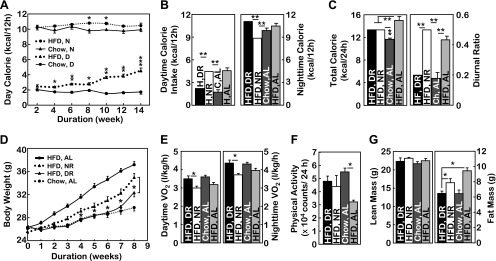Fig. 1.

Feeding circadian rhythm affects body weight independently of caloric intake. A: longitudinal monitoring of daytime (D) vs. nighttime (N) caloric intake in C57BL/6 mice fed normal chow vs. a high-fat diet (HFD) starting at an adult age (∼10 wk old). The data at each time point represent the average daily food intake of each mouse during the week and then averaged per group. B–G: starting at an adult age (∼10 wk), subgroups of male C57BL/6 mice received HFD (H) feeding with daytime restriction (DR) vs. nighttime restriction (NR), whereas the 24-h HFD intake was controlled at the same level. Age-matched male mice under ad libitum (AL) chow (C) feeding or HFD feeding were used as negative and positive controls, respectively. B–D: average daytime (B, left) vs. nighttime (B, right) caloric intake, average total daily caloric intake (C, left), the diurnal ratio (daytime caloric intake divided by nighttime caloric intake) (C, right), and longitudinal follow-up of body weight (D) during the 8-wk intervention period. E–G: mice were measured for oxygen consumption (E) and physical activities (F) by metabolic chambers and lean vs. fat mass composition by magnetic resonance imaging (MRI, G) at 3–4 wk following scheduled feeding. Data on oxygen consumption shown in E were corrected based on the lean mass of mice. A–G: *P < 0.05, **P < 0.01, and ***P < 10−4; n = 6–11 (A–D) and n = 4 (E–G) mice/group. Statistics in A indicate the comparisons between HFD-fed mice and chow-fed mice with matched diurnal cycles. Statistics in D indicate the comparisons between HFD-fed mice under DR vs. NR. Error bars represent means ± SE. H, HFD; C, chow.
